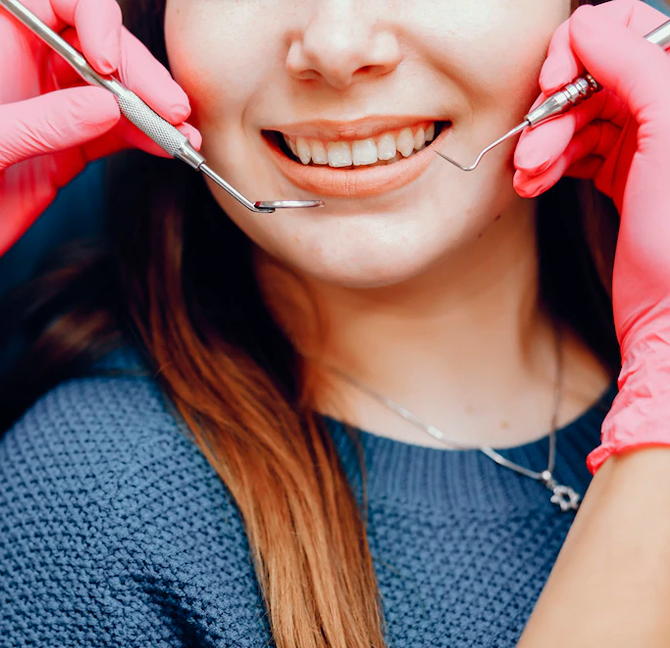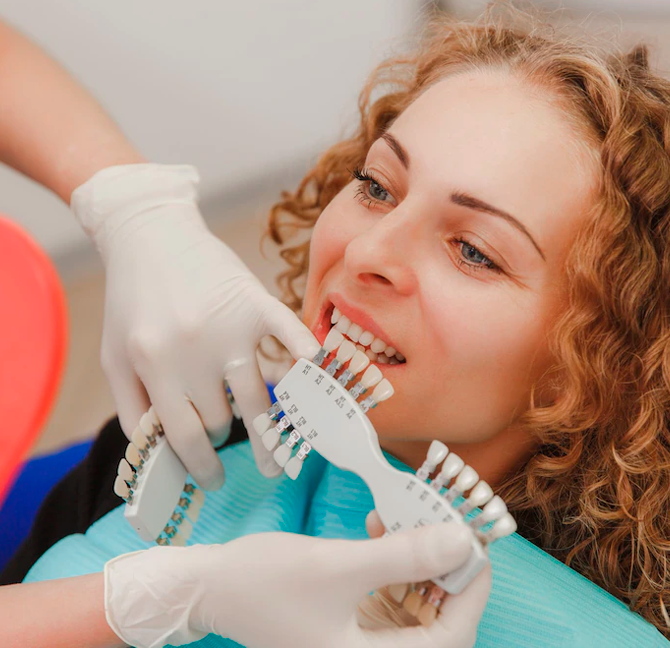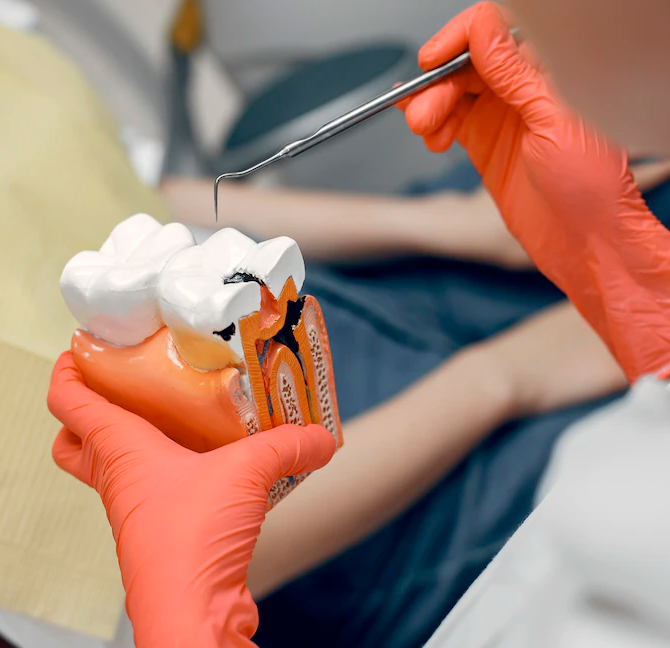General
Dentistry
DENTAL EXAMINATION

It is important to have dental consultation in every six months to prevent, treat, and manage dental problems. During personal dental consultation your dentist perform a detailed examination of your whole mouth. You can also get an accurate picture of your oral health and receive detailed written treatment plan considering your preferences. This means that if any of your teeth needs treatment you could ask your dentist about possible treatment options and also get to know the cost of treatment before commencing your dental treatment.
BOOK AN APPOINTMENT
DENTAL EXAMINATION
Hygienist in Elephant & Castle / Borough
It is important to have professional hygiene treatment on a regular basis (twice a year) to maintain a fresh healthy smile and gum.
Advance ultrasonic instruments remove plaque and tartar deposits without any discomfort and help you to avoid having, teeth discolouration, bad breath, tooth pain, gum disease, gum recession, bleeding gum tooth pain, tooth loss and many others.
Get a fresh, clean, dazzling smile in minutes! Ask our dentist or hygienist for the Airflow treatment.
Airflow treatment is a pleasant and comfortable oral cleaning therapy. It takes just one appointment and will leave your teeth feeling smooth, clean, polished and ready to smile with confidence. Fast, effective stain removal. It uses a spray of air, aesthetic polishing powder and gentle jet stream of water to remove surface stains caused by tobacco, food and drinks etc. It is an excellent option prior to tooth whitening treatments and for maintenance of a beautiful radiant smile. You will immediately see and feel the difference.
Book your Hygienist appointment in our Elephant &Castle/Borough dental practice today and feel how good a smile can be.

Gingivitis: gums go from pink to intense red, slightly increase in size, hurt slightly and bleeding on brushing.
Moderate Periodontitis: gums retract, so teeth look longer and large deposits of tartar on teeth appear.
Advanced or Severe Periodontitis: all previous symptoms increase. Teeth move in excess until they end up falling.
Before proceeding to the first step of the periodontal treatment, the health status of the patient is analysed, as sometimes it is necessary to refer to the general doctor firstly, as general conditions, as diabetes, can be related to periodontal disease and have to be under control.
The objective of therapy against periodontal infection includes minimizing bacterial Plaque. The mechanical treatment that is applied consists in eliminating the damaged tissue of the roots through the meticulous use of manual, sonic or ultrasonic instruments, so that the plaque and tartar are also removed. Once the patient’s oral hygiene is improved, four sessions of deep cleaning would be assessed.
The surgical phase of periodontal treatment should be carried out by specialists, as it includes regenerative and mucogingival Surgeries, as well as a revaluation of the disease. Each patient needs a specific intervention, which usually consists on the elimination of periodontal pockets, regeneration of periodontal tissues, gum and bone grafts.
This part of the treatment will proceed to the placement of dental implants or the definitive prostheses that the patient needs, as well as the assignment of an orthodontic treatment if needed.
The objective of this last phase is to maintain the results obtained during the periodontal treatment, as well as to prevent the recurrence of the disease and to detect new periodontal lesions early. It will consist of several visits with the dentist to confirm that the patient’s oral state and oral hygiene are kept in good condition.
There are several reasons for pulling out a tooth: the tooth is severely damaged or inflamed, which endangers the other teeth. At this stage the tooth is so unstable, loose or drastically damaged that it restricts our chewing capability.
In such cases, removing the tooth and replacing it with an implant is the most appropriate solution.
The biggest enemy of teeth is inflammation, because the bacteria and pathogens causing the inflammation may reach the internal structure of the tooth, not only causing pain, but also resulting in the possible loss of the tooth (or the neighbouring ones).
If the inflammation is so serious that the tooth cannot be treated by root canal treatment and/or anti-inflammatory drugs, then its removal is unfortunately inevitable.
Moreover, the inflammation may loosen the bone structure, so that the jawbone is unable to retain the teeth like it did before it became infected. If the relationship between the bone and teeth weakens, the teeth will lose their biting capability and fall out on their own.
Inflammation can also cause many other diseases such as chronic sinusitis, but patients often experience constant shoulder pain and allergic issues
One of the most difficult parts of the extraction is the removal of infected root(s). The first step of the extraction is taking an X-ray of the tooth and examining the number and position of its roots. This is somewhat easier with the front teeth, as only one root can be found there, whereas molars have 2-4 roots.
The second step is the extraction itself. It is vital to remove pathogens at the same time as the tooth and root, to prevent them from causing further inflammation in the bone and the surrounding gum tissues.
Aftercare is important, so our dentists always inform their patients about what they need to take care of.
The wisdom tooth is our third molar tooth, which generally continues to grow in adulthood. In many cases this can cause problems because the wisdom tooth does not have enough space next to the other teeth. Therefore, inflammation can occur, causing the patient immense pain.
Cases of impacted or unerupted wisdom tooth can be classified into total, not stature (total retention), and partial, not stature (partial retention).
In the case of total retention, the wisdom tooth can be found entirely closed in the bone, below the gum, whereas in a partial retention the crown of the wisdom tooth is above the gum.
Wisdom teeth can be found in a variety of positions, but they usually deviate from the normal position.
It is rare for them to take part in the chewing process without any problems, and they are suitable for prosthetic purposes. All in all, we can say that the removal of wisdom teeth is justifiable in all cases. Wisdom teeth in abnormal situations should be removed even if they are not causing problems.
In most cases wisdom teeth do not have enough space, so they tend to create space for themselves by pushing the full set of teeth forward towards the midline.
In such cases a socket may occur between the tooth and the gum. If food debris, pathogens or bacteria make their way to this socket, it may cause very intense pain, lip lock, fever or inflammation. In order to avoid this, it is highly advisable to have the partially erupted wisdom tooth removed.
This is dangerous because after outgrowth it may irritate the facial mucosal (cheek), cutting into it and causing pain.
The reason for this is that the erupting wisdom tooth may cause compression to other teeth, completely destroying the results of the long and complicated orthodontic treatment.
A non-self-cleaning situation may develop in the crowded back of the mouth that is hard to reach and cleaned, even with a toothbrush.
The wisdom tooth and its roots can be located close to the jaw nerve, and nerve pressure may cause a variety of types of pain from a dull ache to intense pain.
In such cases the solution might be the removal of the wisdom tooth or – if there is some chance of a normal eruption – helping its eruption. So, in those rare occasions when the wisdom tooth is able to erupt adequately and, for example, the front molar is missing, there are methods to help the eruption. However, preserving the wisdom tooth is only advisable if it is able to take part in the chewing process, if the patient is able to clean it properly or if it can be used later for prosthetic purposes
WISDOM TOOTH

Wisdom tooth
extraction
The wisdom tooth is actually our third molar tooth, which generally continues to grow in adulthood. In many cases this can cause problems because the wisdom tooth does not have enough space next to the other teeth. Therefore, inflammation can occur, causing the patient immense pain.
Cases of impacted or unerupted wisdom tooth can be classified into total, not stature (total retention), and partial, not stature (partial retention).
In the case of total retention, the wisdom tooth can be found entirely closed in the bone, below the gum, whereas in a partial retention the crown of the wisdom tooth is above the gum.
Wisdom teeth can be found in a variety of positions, but they usually deviate from the normal position.
It is rare for them to take part in the chewing process without any problems, and they are suitable for prosthetic purposes. All in all, we can say that the removal of wisdom teeth is justifiable in all cases. Wisdom teeth in abnormal situations should be removed even if they are not causing problems.
1. Because of the lack of space, wisdom teeth may cause forward compression of the full set of teeth. In most cases wisdom teeth do not have enough space, so they tend to create space for themselves by pushing the full set of teeth forward towards the midline.
2. The eruption of teeth has a partial obstacle and is able to break through the gums at a certain point. In such cases a socket may occur between the tooth and the gum. If food debris, pathogens or bacteria make their way to this socket, it may cause very intense pain, lip lock, fever or inflammation. In order to avoid this, it is highly advisable to have the partially erupted wisdom tooth removed.
3. The wisdom tooth can be found in an abnormal position, pointing to the outside of the face.
This is dangerous because after outgrowth it may irritate the facial mucosal (cheek), cutting into it and causing pain.
4. It is worth removing the wisdom tooth before orthodontic treatment.
The reason for this is that the erupting wisdom tooth may cause compression to other teeth, completely destroying the results of the long and complicated orthodontic treatment.
5. The wisdom tooth straining the rear surface of the second molar may cause tooth decay.
A non-self-cleaning situation may develop in the crowded back of the mouth that is hard to reach and cleaned, even with a toothbrush.
6. The unerupted wisdom tooth may cause neuropathy-like pain in the lower jaw.
The wisdom tooth and its roots can be located close to the jaw nerve, and nerve pressure may cause a variety of types of pain from a dull ache to intense pain.
7. The eruption of the wisdom tooth may cause intense pain and lip lock on its own.
In such cases the solution might be the removal of the wisdom tooth or – if there is some chance of a normal eruption – helping its eruption. So in those rare occasions when the wisdom tooth is able to erupt adequately and, for example, the front molar is missing, there are methods to help the eruption. However, preserving the wisdom tooth is only advisable if it is able to take part in the chewing process, if the patient is able to clean it properly or if it can be used later for prosthetic purposes.
If significant part of the tooth is missing and cannot be adequately replaced by conventional filling because the filling may fall out, then an inlay can be applied.
The first part of the procedure is very similar to that for a conventional filling. The dentist removes and damaged and decayed parts. Afterwards, however, the tooth is not filled but – in a similar way to crowns, bridges and veneers – an impression is taken from the cleaned part that the dental technician will use to prepare the inlay.
This inlay is then attached to the missing part of the tooth.
The inlay can be made of various materials: composite, ceramics, gold or zirconium
Once this tooth-coloured inlay has been attached, the damaged tooth has its original shape, colour, chewing capability, and function restored.
The tooth-coloured inlay is a very durable and aesthetic type of filling: the lifespan of well-prepared inlays can be many times longer than conventional fillings.

The root canal is a layer of pulp found deep inside the roots of your teeth which contains nerve tissues. When pulp is infected a root canal treatment is needed to put an end to pain and abscess. During this procedure, the infected pulp tissue is removed, and the affected root is cleaned, disinfected and filled in. A crown is then fitted onto the weaken tooth to prevent future inflammation and improve aesthetic appearance. In many case root canal procedure can help to avoid tooth and the surrounding bone structure from being lost.
The number of root canals in the tooth may vary from one to four, and usually requires 2-4 visits.
You might need a root canal if:
We use the most advanced digital apex locator and rotary system for root canal treatment to release your pain and save your tooth.
Even with excellent oral hygiene and meticulous flossing sometimes we can’t avoid tooth decay which is in most cases can be treated with tooth filings. Tooth filling is the most common dental treatment among adults and children, and it is used in general dentistry as a basic restorative treatment to avoid further damage of teeth or tooth loss.
Bacteria can create small hole in your tooth often causing tooth pain or sensitivity. This small hole or cavity can be closed down with tooth filling. There are different types of fillings like composite, (tooth coloured or white filling), temporary filling, root canal filling and amalgam filling. Dentist always perform the most suitable one considering the type of cavity you have.
Dental X-ray is used to prove the presence of cavity. During tooth filling process local anaesthetic is applied. Once the affected area is completely numbed the decayed parts of the tooth are removed with drills and special instruments and a hole is also disinfected.
To avoid sensitivity after the treatment, very thin layers of resin are placed inside the hole. Then the tooth coloured, resin material is packed in and a blue light is used to make it set within a few seconds.
It’s very simple. As the decay doesn’t disappear without receiving filling treatment it goes further down inside the tooth. When it reaches the pulp, we start feeling sensitivity or even intense tooth pain and if the tooth not treated on time the infection can spread further in the root canal which might result in the loss of a tooth or additional root canal treatment.
Avoid costly and complicated tooth loss or additional treatment book an appointment with one of our dentists.
The cost of tooth fillings is various and depends on the chair time of the treatment and the type and amount of material your dentist needs to restore your teeth. For example, a temporary filling costs less than a white filling as it requires significantly less treatment time and material. In case of white, composite filling we differentiate small, medium and large filling and its’ prices vary accordingly.
Despite amalgam filling costs relative less and are still widely used for filling cavities it is proved that they can negatively affect your overall health.
Amalgam fillings consists of silver, mercury and tin which can cause brain damage, cancer, and can constantly weaken the immune system and many others. They also need much more tooth preparation and can’t eliminate tooth decay completely not to mention the bulky and black appearance which is cosmetically not appealing.
Our dentists use only white, tooth coloured filling that blend right in with your teeth. They are made of porcelain, composite resins, or other high-tech materials which don’t harm your health and environment. They typically require less removal of tooth’ structure and perfectly seal off cavities ensuring you an indistinguishable appearance from your natural teeth.
DENTAL BRIDGE

If a tooth is completely missing a bridge can be an alternative solution. However, bridgework requires that the healthy teeth on either side of the gap be prepared for crowning. Then, a single unit crown in the shape of all three teeth is anchored to prepared teeth, and the bridge is complete. It is advisable to have bridge only if teeth are damaged on both sides of the missing tooth.
It teeth are intact a dental implant is the right choice.
We offer conventional porcelain fused to metal and more aesthetic , metal free zirconium bridge.
To replace missing tooth or teeth
If old bridgework is wear down
If bridgework doesn’t seal properly that may cause severe gum disease and gum receding.
In case of multiply teeth loss, dental implants are used as a base or pontic to support the bridgework. ( for example; three missing teeth in row can be replaced with two implants and a 3-unit bridge.
High quality
durable
affordable price
Chipped, discoloured tooth can be restored by dental crown.
A crown is simply a tooth-shaped cap that places over a damaged or discoloured tooth to restore its shape, size and to improve its overall appearance. Crowns can be made of various materials: at our clinic we use full zirconium, porcelain and porcelain-fused-to-metal crowns.
Patient can decide the shape, shade and colour of the crowns before the final fitting.
Porcelain-fused-to-metal crowns withstand the chewing force better, it rarely chips and more durable than full porcelain crowns. However, over time the metal underlying the porcelain layer can present black line at the gum line especially if the gums recede. These crowns can be used for the front and back teeth.
Full porcelain crowns can ensure the highest aesthetic result, however they don’t last that long like porcelain-fused-to-metal crowns. Full porcelain crown can be used for front teeth and they are ideal choice for people with metal allergies.
You may need crown in the following situations:
